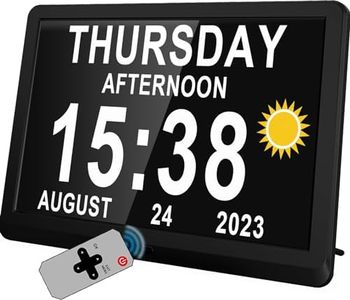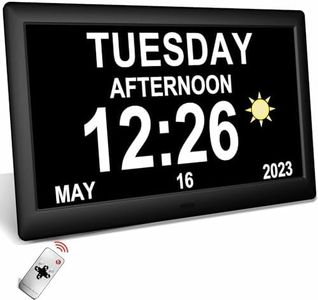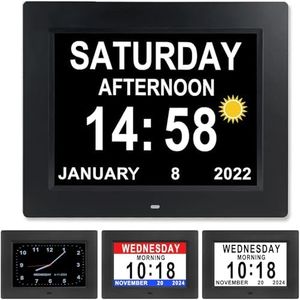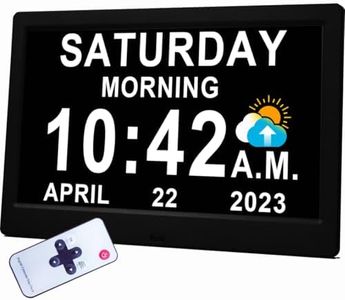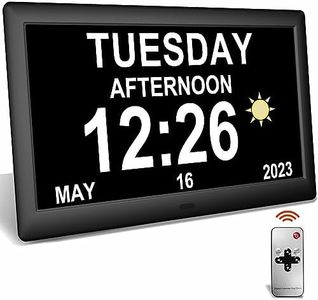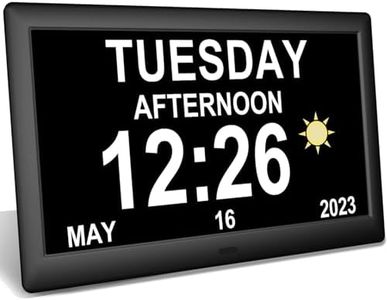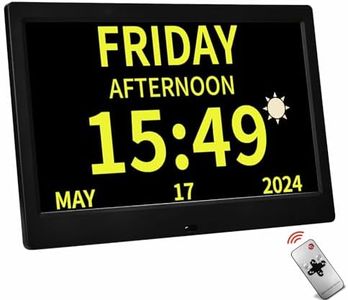We Use CookiesWe use cookies to enhance the security, performance,
functionality and for analytical and promotional activities. By continuing to browse this site you
are agreeing to our privacy policy
10 Best Dementia Clocks
From leading brands and best sellers available on the web.Buying Guide for the Best Dementia Clocks
Choosing the right dementia clock is important for maintaining a sense of orientation and reducing confusion for individuals living with memory issues. Dementia clocks are specially designed to display time and date information clearly and simply, helping users keep track of day, date, and time. When selecting the best fit, consider the user's specific challenges, vision abilities, and routine. The aim is to pick a clock that improves independence without overwhelming the user with unnecessary features.Display TypeDisplay type refers to how the information is shown on the clock, such as analog hands, digital numbers, or even both. This is important because someone with dementia might struggle to interpret traditional clock faces. Digital displays with large, clear numbers and words tend to be easier to understand. Analog displays may suit those who are familiar with and comforted by more traditional clocks. Think about the user's familiarity and current ability to read displays. If they have trouble reading numbers or interpreting clock hands, a large, uncluttered digital display will likely be best.
Information DisplayedSome dementia clocks show just the time, while others also show the day, date, and sometimes even whether it's morning, afternoon, evening, or night. This aspect is crucial because people with dementia often lose track of which day or part of the day it is. The more information that is clearly shown, the easier it is for the user to orient themselves. However, too much information can be overwhelming for some people. If the primary need is to reduce confusion between day and night, choose a clock that prominently displays both the time of day and whether it's AM or PM, or uses wording like 'morning' or 'evening.'
Size and ReadabilityThis refers to the overall size of the clock as well as the text and screen size. Larger clocks with bigger, high-contrast text are easier for people with visual impairments or cognitive decline to read. Consider where the clock will be placed – on a bedside, wall, or across the room – and choose a size that will be visible from the likely viewing distance. For most, simple, bold fonts and high-contrast colors (such as white letters on a black background) are easier to recognize.
Alarm and Reminder FeaturesMany dementia clocks come with built-in alarms or the ability to add reminders, which can be helpful for medication, meals, or appointments. This feature is important if the user has set activities they need to remember throughout the day. However, for some users, extra alarms may cause confusion or anxiety, especially if they’re not accustomed to using them. Consider the user's daily routine – if reminders are beneficial and can be explained easily, choose a clock with multiple, customizable alarms. Otherwise, a simpler model may be more suitable.
Power SourceDementia clocks can be powered by batteries, mains electricity, or both. This is important because users may forget to change batteries or plug the device back in after moving it. Clocks that run on mains power are more reliable for uninterrupted operation but need to be placed near an electrical socket. If the clock will be moved often or used where mains power isn’t available, a battery-backed or dual-power model might be best. Consider the living environment and likelihood of needing portability versus reliability.
Volume and Alert OptionsFor clocks with alarms or voice reminders, being able to adjust the volume is crucial, especially if the user is hard of hearing or sensitive to loud noises. This spec is important because a clock that's too quiet won't get noticed, and one that's too loud could cause distress. Look for models that offer a wide volume range or vibrating or flashing alert features if sound isn’t ideal. Match the alert style and loudness to the user’s preferences and needs.
